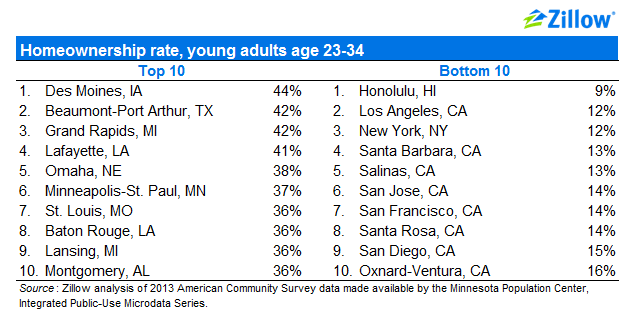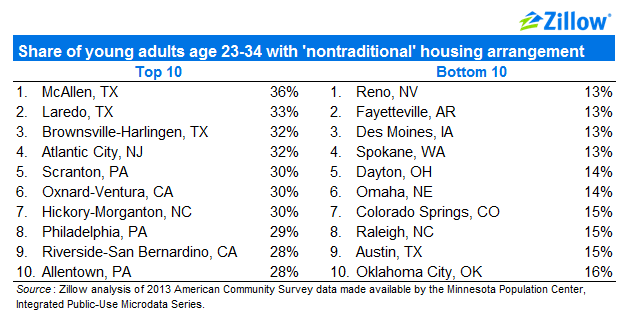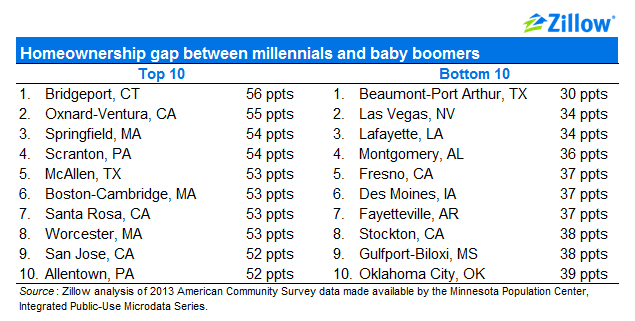- Young adults seem to be most successful at buying homes in the middle of the country, in markets including Omaha, Minneapolis and St. Louis. Millennials have lower homeownership rates in larger coastal metros, particularly in California.
- Metros with the highest rate of “non-traditional” living arrangements among millennials (i.e., living in a home they don’t own and where they don’t pay rent) include Philadelphia and Riverside, California.
- The metros where the generational gap in homeownership rates between millennials and Baby Boomers is smallest include Las Vegas and Oklahoma City.
The U.S. homeownership rate has declined to three-decade lows, driven down in part by steadily declining homeownership among young adults confronting a trifecta of housing headwinds: Historically tight credit conditions; a weak labor market; and the fact that job growth is generally strongest in the most expensive cities.
Still, just because it’s sometimes difficult doesn’t mean millennials aren’t interested in homeownership, or aren’t buying homes at all. In certain areas (generally the Midwest and South), young adults have been relatively successful at overcoming these obstacles and becoming homeowners—even as they continue to struggle in other places.
The Minnesota Population Center (MPC), which allows researchers to take a detailed look at individual household responses published by the U.S. Census Bureau, recently released data for the 2013 American Community Survey (ACS). Using this newly available data, we are able to take a fine-grained and custom look at homeownership across the United States.
While the census reports the overall homeownership rate, the data can be difficult to interpret since adults residing with family members are, by default, assigned the homeownership status of their relatives. However, in recent years, the number of adults—especially young adults—residing with family members out of economic necessity has increased, leading the default to overstate the actual number of adults who own a home.
Using the MPC data records, we are able to avoid counting as homeowners those young adults residing with parents or other family members, those currently enrolled in school and those residing in group quarters (such as dormitories, prisons or medical facilities). This better captures the homeownership rate of working-age emerging adults.
The top and bottom 10 metro areas where millennials are or are not “making it happen”—that is, buying homes—are listed below. Young adults seem to be most successful at buying homes in the middle of the country. Major urban areas including Omaha, Minneapolis and St. Louis make the top 10 list for places where young adults have been successful at becoming homeowners. By contrast, young adults are not buying homes to the same extent in the country’s expensive coastal metros, particularly in California.
The top and bottom 10 markets for the share of young adults living in otherwise “nontraditional” living arrangements—that is, young adults who don’t own a home and don’t pay rent—are listed below. These young adults overwhelmingly reside, rent-free, with family members or friends. Philadelphia and Riverside, California, are among the metros with the largest shares of these young adults, along with several South Texas markets. Young adults tend to have more traditional living arrangements—either as homeowners or check-writing renters—in metros including Omaha, Colorado Springs, Raleigh and Austin.
Finally, the places with the largest and smallest gaps between the homeownership rates of millennials (age 23 to 34) and Baby Boomers (age 50 to 64)—that is, the places with the most and least homeownership inequality across generations—are listed below. Places with the most generational inequality are concentrated in New England and California. Places with the least generational inequality tend to be in the South and West, with several prominent metros making the list, including Las Vegas, Fresno and Oklahoma City.


